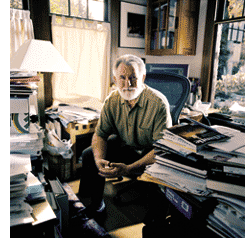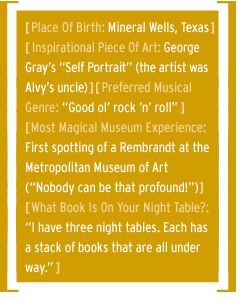Alvy Ray Smith

Published for the Week Of December 13, 2004

The artist caressed the velvety crimson rose with his brush, adding a subtle dimension of color. No painter’s palette his medium. At his hand, a primitive digital tablet and stylus with which he lovingly applied each layer of electronic paint, waiting patiently for the image to re-render with every new stroke.
Even though he was absorbed with his creation, Alvy Ray Smith III sensed Ravi Shankar’s aura immediately, the musician’s perfume wafting to his nose from several feet away. As was common, a colleague was showing off the Lucasfilm labs in San Rafael, Calif., where Smith and others were experimenting with nascent digital graphics technology. Smith was expected to provide a quick demonstration of what wonders could be worked.
After a quick tutorial, he made a random gesture on the tablet with his stylus. “Everyone is feeling good because we’re seeing the future,” Smith recalls thinking. And then, the magic took hold: The green line formed by his casual stroke gracefully looped up toward the rose on the screen, endowing it with a delicate stem. Shankar virtually vibrated with pleasure, and Smith stared at the display in wonder.
“It was just one of the best things that has ever happened to me,” Smith, 61, whispers, still awed with the telling years later.
Today, his feat may sound trivial. But nothing to do with art or computer graphics has ever been trivial to Alvy Ray Smith, who combines the soul of an artist with the mathematical intellect of a computer scientist. It is this unique combination and Smith’s tireless work in creating software that could emulate the qualities of paint on a PC that have cemented his place of honor in the annals of computer industry history.
| AD | |
|---|---|
| id | unit-1659132512259 |
| type | Sponsored post |
“My first impression was that here was this gentle giant, or graceful giant, who was as excited as me about moving the pixels around on a computer screen,” says David DiFrancesco, a longtime colleague who met Smith in the early ’70s through Xerox PARC.
There, it was Smith’s job to create the “art” for an experimental computer paint program developed by another one of his career-long collaborators, Dick Shoup. Smith used Shoup’s system to develop animated characters’ walking patterns or random color sequences, drawing on a book written by Preston Blair, who contributed the dancing hippos sequence to one of Smith’s favorite animated works, “Fantasia.”
Smith output his own ideas onto one-inch videotape in a series called “VidBits.” He recalls: “I had a vision of what I could be doing. It was making pictures with the computer and making them move.”

\
But Xerox PARC decided its future wasn’t in color, and Smith and Shoup found themselves out of a job. It turned out to be one of their luckiest breaks. The two, along with DiFrancesco, searched the country for another facility with the backing (read: money) to invest in the hefty equipment they needed to continue their work. They landed at the New York Institute of Technology in Westbury, N.Y., where they met Ed Catmull. This core of scientists, along with several other individuals who joined them later at Lucasfilm in California, formed the nucleus of the team that would go on to found the now-legendary Pixar Animation Studios.
“We all had interests from varied fields of expertise that we had gained in college or life experiences,” recalls DiFrancesco, still a senior scientist at Pixar. “Some of us had math and some had engineering, some had arts, optics and so forth. Every one of us came with more than one. Alvy certainly brought the two-dimensional paint program in all its glory, and he came from a computer science background.”
Indeed, Smith’s Ph.D. dissertation from Stanford University was on cellular automata theory, a branch of physics that looks at the state of objects in space and time, a field that he would later apply to his animation work.

Smith’s 84-year-old father, Alvy Ray Smith II, says his son’s interest in art emerged early, pointing to early photography experiments that kept him out of teenage mischief. His talent would also provide a turning point during Smith’s engineering study at Stanford, when he won a local art contest he had entered on a whim. “They didn’t understand what he was doing before that,” the elder Smith says.
Aside from his artistic sensibilities, former colleagues said the good-natured Smith often helped nurture technical projects behind the scenes, buffering the engineers from the business side. “It was a very organic kind of management,” says Loren Carpenter, senior scientist at Pixar. “What Alvy did was act as an intermediary.”
Smith’s decision to leave Pixar in 1991 to found Altamira Software was born of his revelation that the personal computer, which he had largely ignored up to that point, could bring graphics technology to more creative souls. The “Iceman” technology birthed at Pixar, based on its Image Computing Exchange Language (ICICLE) and then extended at Altamira, was used to create a whole set of programming interfaces that made it easier to handle digital images. Apparently, Microsoft agreed—it moved to acquire the company in 1994, retaining Smith as a fellow for about five years.
Smith retired in 1999 to work on what he calls “old man projects,” including genealogies for his parents. He received two awards for his book about his mother’s branch of the family and now is working on his dad’s side.
Marsha Rising, an officer of the American Society of Genealogists, who corresponds regularly with Smith, says he has quickly established himself as a serious researcher. “Alvy wants to learn,” she says. “He’ll ask. He recognizes where he’s strong and where he needs to learn, and that is unusual.”
When he’s not dabbling in family trees or reading dozens of scientific treatises and history books, he steeps himself in digital photography. Chances are, we haven’t heard the last of Smith when it comes to technical breakthroughs that will revolutionalize the culture of art.
“I like to talk to artists. I do it a lot. And what I like to tell them is, ‘Don’t take the machines as they’re given to you. Don’t take the software as it’s given to you,’ ” Smith muses. “The computer is the most malleable tool that’s ever come down the pike. And one of the things that most of the rest of us need the artists of the world to do is to tell us what in the heck it is we have here. What is this medium? What can we do with this thing? So far, only the technical people have explored it and told us what’s going on there. But I know there’s a lot more.”